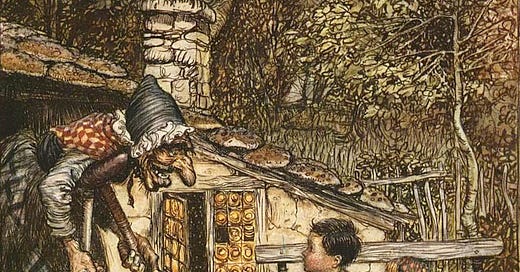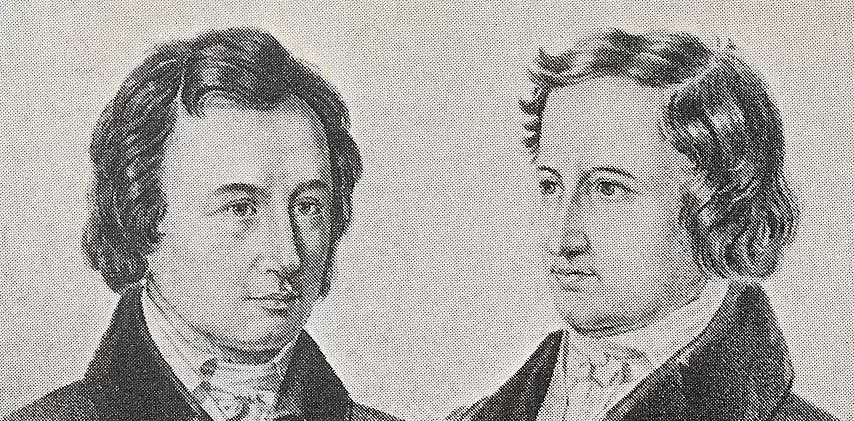Gathering Family Tales: How to Collect Stories Like the Brothers Grimm
Preserving Voices of the Past
I was born the son, grandson, and great-grandson of what have been described as three great storytellers. While I never met my great-grandfather, my father told me that as a young man, he longed to hear the stories his grandfather would share at family meals. I can picture it now: an old kitchen table in Vine Grove, Kentucky, the clinking of silverware, voices hushed to listen as a story unfolded.
My grandfather was no different. Every interaction I had with him in the 1980s in Flaherty, Kentucky, came with a story. These were the days before the internet and social media, when storytelling wasn’t just a way to pass the time. It was how we made sense of the world. He told tales of growing up on a farm, of his childhood adventures, of the time he talked a disgruntled employee out of shooting him and his co-workers. These weren’t just idle anecdotes. They were part of the way he communicated who he was and what he had experienced.
And then there was my father. Born in a log cabin during World War II, he was a natural storyteller who could talk to anyone, anywhere. He had a way of putting people at ease, reminding me often, “He puts his pants on like everyone else… one leg at a time.” He was just as comfortable talking to an elected official as he was to a gas station attendant. And like my grandfather before him, he was a voracious reader. Every Thursday, we made a ritual out of visiting our local library, each leaving with a stack of books. Storytelling was woven into the fabric of our lives, a core value that shaped the way I see the world.
My grandmother came from a German family, and on the shelves of her basement library sat several books by the Brothers Grimm. As a child, I remember running my fingers over their worn spines, not yet realizing the significance of the stories inside. Later, as I grew older, I became more conscious of the role storytelling plays—not just in entertainment, but in how we preserve our history. And I started to pay attention to the great story collectors. Among them, the Brothers Grimm stand out as the first among equals.
More Than Just Fairy Tales
Jacob and Wilhelm Grimm are known for their fairy tales, stories that have been retold so often they feel like they’ve always existed. But the Grimms weren’t simply entertainers. They were cultural preservationists. They knew that stories weren’t just make-believe. They carried the history, values, and struggles of the people who told them.
The way they gathered their stories offers lessons for anyone who wants to preserve the past. They didn’t just collect folklore. They sought out multiple tellers, documented different versions, and shaped the stories so that future generations would understand their significance. This approach is just as valuable today for those of us who want to collect and pass down our own family stories.
Listening Widely
The Grimms didn’t rely on a single source. They spoke with people from different villages, backgrounds, and social classes, knowing that every voice carried something unique. A peasant’s version of a tale might differ from a nobleman’s, but both were worth preserving.
That same principle applies to family stories. No single person holds the whole truth of the past. A grandmother may recall a family event with wisdom and nostalgia, while an uncle remembers the humor in it. A cousin might recall details that others forgot entirely. If you only listen to one person’s version, you’re missing pieces of the bigger picture.
Some of the best stories come from unexpected places. A relative who isn’t particularly talkative might reveal something incredible when asked the right question. An old neighbor might remember things about your grandparents that no one else does.
Looking Beyond the Family Circle
Recently, I attended an estate sale. The husband of the owner of the company was there, and I recognized him. I had met him once before, many years ago. His father had owned a fine furniture and antique company where my maternal grandfather worked as a furniture maker and restorer.
My grandfather has been gone for 33 years, but this man remembered him vividly. He recalled working alongside him in the 1970s and 1980s and shared a couple of anecdotes about their time together. Standing in the middle of an estate sale, surrounded by someone else’s history, I unexpectedly gained a piece of my own.
Experiences like this remind me that family stories don’t just live in the memories of our closest relatives. They exist in the people who knew them—their friends, their co-workers, their fellow church members, their neighbors. If you want to learn more about your ancestors, reach out to those who once shared space with them. You never know who might hold a story that has never been told.
Embracing the Differences
When the Brothers Grimm collected fairy tales, they often found multiple versions of the same story. Sometimes the details were small—a name or a setting changed. Other times, entire endings were different. Rather than choosing one version as correct, they documented the variations, knowing that these differences were just as important as the core story itself.
Family stories work the same way. Ask three siblings about a childhood holiday, and you’ll hear three different versions. One remembers the magic, another remembers the chaos, and the third might recall something that no one else does. None of them are wrong. Memory is subjective, shaped by emotion and experience. The real story often lives in the spaces between these accounts, in the common threads and contradictions alike.
Context Matters
The Grimms didn’t just write down fairy tales word for word. They refined them, making them accessible to future generations. They understood that stories without context could become meaningless over time.
The same is true for family history. If a story is passed down without explanation, it risks becoming a vague anecdote rather than something meaningful. A grandfather’s story about working in a factory isn’t just about labor. It’s about what work meant at that time, how it shaped his identity, and what it meant for the family’s survival. A great-aunt’s recollection of a childhood blizzard isn’t just about the weather. It’s about resilience, hardship, and the way communities came together.
Adding context ensures that stories remain alive. It means asking questions that go beyond "what happened?" and instead exploring "why did it matter?"
Preserving the Spirit of a Family
The Grimms’ stories weren’t just about characters. They captured the fears, hopes, and values of the people who told them. Family stories do the same. They reveal what mattered to those who came before us.
As you collect stories, look for patterns. Do themes of perseverance or adventure appear again and again? Do certain qualities like stubbornness, generosity, or humor show up in every generation? These themes can tell you just as much about your family’s identity as a genealogy chart.
Some stories will be dramatic—about survival, love, or loss. Others will be small moments of everyday life. Both are valuable. Not every story needs to be grand. Sometimes, the simplest memories—the way a grandmother made biscuits, the way a father sang off-key in the car—are the ones that carry the most meaning.
And then there are the people who stand out. Every family has them—the bold ones, the storytellers, the mischief-makers, the larger-than-life personalities. They’re the ones whose names come up again and again at gatherings, whose stories get retold for years. Preserving their stories ensures that their spirit remains part of the family’s legacy.
Carrying Stories Forward
The Brothers Grimm weren’t just preserving fairy tales for their own enjoyment. They were creating a lasting record so that future generations would understand the culture and traditions of their time. As family storytellers, we have the same responsibility.
Some of the stories we collect today will be passed down for generations. Others will help connect us more deeply to the people around us right now. Either way, they matter.
If I hadn’t taken the time to speak with the man at the estate sale, the anecdotes he shared about my grandfather might have been lost forever. It was a reminder that the stories most at risk of being forgotten are often the ones that matter most. This idea sits at the heart of the Corn Island Project. What’s forgotten is often what holds the deepest meaning. Family stories, like history itself, don’t always disappear in a single moment. They fade gradually, slipping away unless someone takes the time to ask, to listen, and to preserve them before they’re gone.
So start collecting. Talk to relatives. Seek out old friends and co-workers. Write things down. Record voices. Save letters. Capture the moments that define your family, because once a story is remembered, it is never truly lost.
Much like the fairy tales of the Brothers Grimm, the stories of our families deserve to be told, over and over again, for generations to come.








This is a really great and important read and a wonderful way of describing why stories matter and why and how we can think about telling, sharing and preserving them. Thanks!
This advice jumped out at me: "family stories don’t just live in the memories of our closest relatives. They exist in the people who knew them—their friends, their co-workers, their fellow church members, their neighbors. If you want to learn more about your ancestors, reach out to those who once shared space with them. You never know who might hold a story that has never been told." I wish I'd thought of talking to my grandparents' surviving friends and neighbors when they were still with us. They would have had some interesting perspectives on my family and their world.